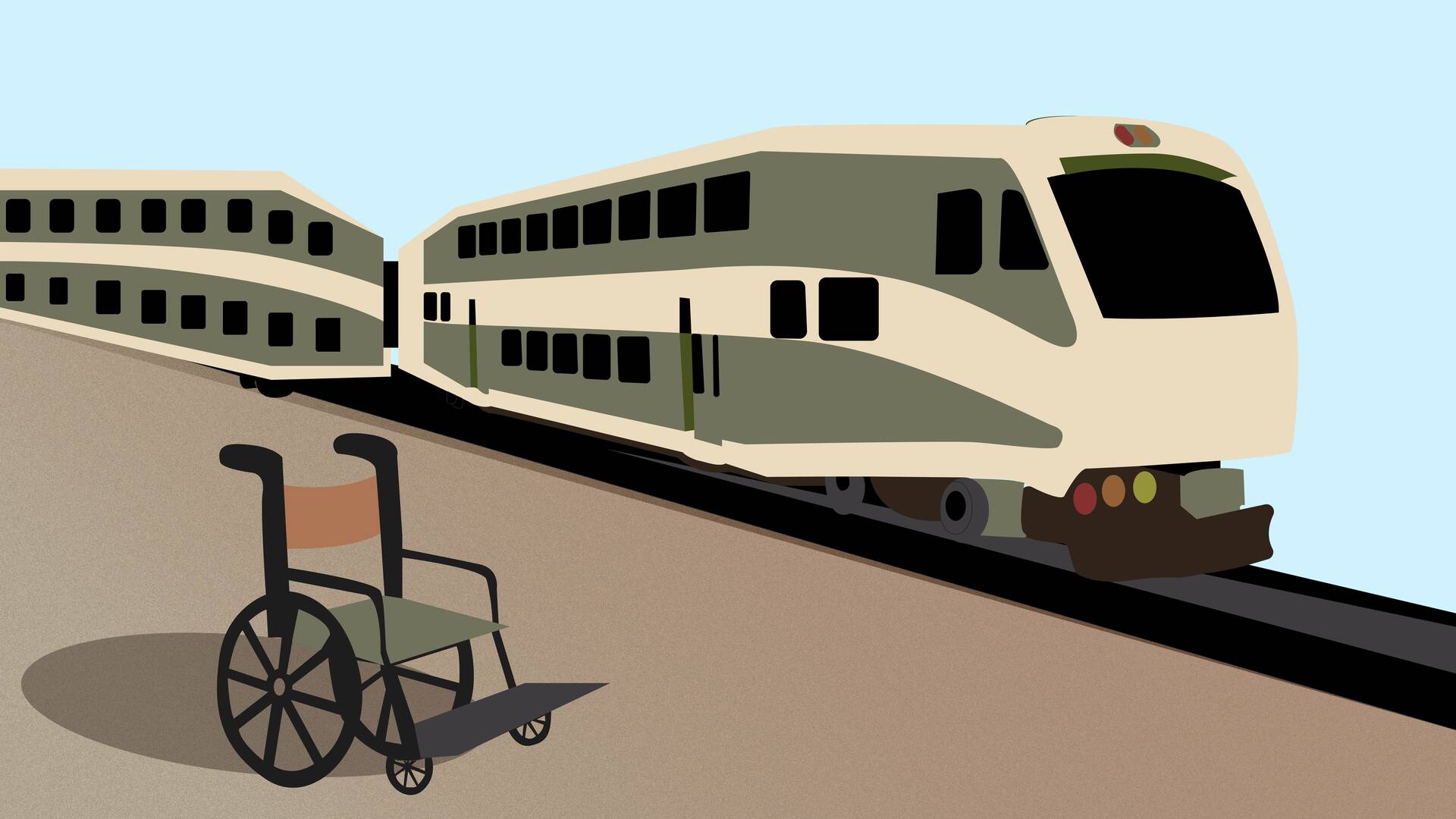When Aziza Agasee visited California in 2016, her trip quickly turned sour. On her flight, her wheelchair's power assist—which is a motor attached to a manual wheelchair—was damaged during the flight. This equipment costs thousands of dollars, and luckily Agasee was able to successfully file for reimbursement. Still, this process created unnecessary stress and made the trip more difficult for the third-year politics and governance and sociology student as she could no longer rely on the feature when she was fatigued.
“It is very difficult to fly with a disability,” she says. Customer service is one of the biggest issues when travelling by air, Agasee explains. “It's not even just all the pre-planning and kind of calls you have to make in advance, but it's the plane staff. They're not very understanding or accommodating to people, especially when it comes to your own equipment.”
Heather Willis, the accessibility coordinator at Toronto Metropolitan University (TMU), says airplanes are inaccessible and not designed to accommodate disabled passengers. Disabled people are unable to use their own mobility aids on board, forcing them to rely on others and removing their sense of independence.
“It's all this extra planning that other people take for granted,” says Willis. She explains that the amount of time and energy it takes to plan simple day-to-day events while away from home can be the most discouraging part of travelling. Considerations must be made surrounding every destination on the journey, she says.
For Agasee, travelling is already a stressful experience due to the amount of consideration she needs to take and the variables which can go wrong. “You don't look forward to wanting to go anywhere, knowing you have to go through that,” she says.
While an able-bodied traveller may only have to worry about finding the best rates on flights and hotels, disabled students at TMU might also have to consider the accessibility of those services.
Travel can mean more than just going on vacation. Many TMU students commute from outside of the downtown core to get to school every day and for some, this can be more challenging than others. The Toronto Transit Commission (TTC) is yet to become a fully accessible service, with multiple subway stations lacking elevators and bus stops having little to no indicators for the blind. College station, for example, is only accessible by stairs. While the city's
Wheel-Trans service—a shared-ride public transport system that utilizes accessible vans, buses and taxis—is available, it is not necessarily timely nor comprehensive, says Willis.

As a wheelchair user, Agasee also takes an accessible taxi from Thornhill, Ont. when commuting to TMU. She says her previous experiences with public transportation have discouraged her from taking the subway. “I do know that not every subway station is accessible, so that's one of the main reasons why I haven't tried it yet,” she says.
Only 54 of the 75 TTC subway stations have elevators, making up about three-quarters of the stations, according to the
TTC website. The lack of accessible transportation has a major impact on many lives, says Willis. A 2021
Statistics Canada study found that 17.8 per cent of Canadians with disabilities who consider themselves housebound attributed that to the unavailability of specialized public transportation.
As the accessibility coordinator at TMU, Willis works to create an accessible and inclusive university for all students. Willis, who is a wheelchair user, has used the Wheel-Trans service and the GO train to commute to TMU from Scarborough.
She notes what would typically be an hour-long commute takes her twice the time. She applauded the GO train for its accessibility and is glad the TTC’s Wheel-Trans service is offered, but wishes it was more comprehensive so passengers didn’t have to book days in advance or experience long rides and wait times.
The TTC said in an emailed statement to The Eyeopener, “The TTC is fully committed to giving our customers transit options through system accessibility programs, through Wheel-Trans and by creating a seamless integration of the two systems through Family of Services.”

Macenzie Rebelo, a first-year master of journalism student at TMU, has lupus. She says travelling often doesn’t feel like a realistic option to her due to the amount of unknown factors and activities she can’t participate in due to her illness. Lupus is a chronic autoimmune disorder, Rebelo says, that can affect her lungs, mobility and causes fatigue and chronic pain among other effects. “It's just not enjoyable, you kinda just stick out like a sore thumb and you just have to really plan out everything,” Rebelo says.
Agasee says she is often hesitant to go on trips or visit new places, worrying that her travel companions might not be understanding of the accommodations and the amount of preparation she needs. “I kind of get insecure…that person may not be understanding or may not understand what it's like.”
Accessibility may not look the same for everyone—both the definition and needs vary from person to person, says Willis. “Understanding accessibility and accommodation as different approaches is something that's been really key,” she says. She explains that accommodation is needed when a space is not accessible, yet the two often rely on each other.
“The more accessibility you have, the less individual accommodation you're going to need,” says Yin Brown, the director of inclusion, diversity, equity & accessibility at
Abilities Centre. She mentions that her needs as a blind person vary drastically from those of a wheelchair user. Because of this, the aids she utilizes are different from those with other disabilities, but this is often misunderstood.
“If you go to the desk and ask for assistance as a person with a disability, right away they make certain assumptions,” says Brown. She says often when requesting a guide, she is given a wheelchair despite being able to walk.
Brown spoke about the issues with current “
Accessibility for Ontarians with Disabilities Act ” standards, which “mandates how organizations must remove and prevent barriers for people with disabilities,” according to their website. These standards apply to all organizations, public, private and non-for-profit, in Ontario. Brown says while the standards could be stronger, the biggest issue is enforcement.
The lack of enforcement and weak penalties allow for non-compliance, she says. “Many organizations, big and small, have no idea that they should comply and they get away with it.”
Agasee expresses frustration with the broad nature of the term ‘accessibility’ as well. When staying at hotels in the past and booking rooms advertised as accessible, she has been placed in rooms which were not barrier-free. This caused her to ask, what does accessible truly mean ? “I guess their version of accessible and my version of accessible is very different,” says Agasee.
Willis shares a similar experience with staying at hotels, mentioning it especially when booking an accessible room. For example, while the bathroom may be accessible, there are often other barriers such as high beds. “The bed was about a foot higher than my chair. So it was very unsafe for me to be transferring,” says Willis.
Robelo says she’s often unable to get the support she needs due to a lack of awareness or understanding of those who are not visibly disabled. She says she has a lot of anxiety about utilizing spaces and services accommodated for disabled people. In the past, she’s been harassed out of handicapped parking spaces or unable to use designated seats on public transit. “It can just feel like there's more cons than pros when travelling sometimes and it's not worth it,” says Robelo.
Brown’s main recommendation on how to make travel accessible was to increase training. Regardless of the profession, employees should be trained in how to help disabled people and make their services accessible, she says. Whether it be bus drivers, flight attendants or restaurant owners, changes need to be made at a human level, not only an industry level, Brown says. This sentiment was echoed by everyone interviewed.
Brown emphasizes the importance of working with communities to create an accessible society rather than guessing what disabled people need. “The solution is to really work with the population group that you feel you want to travel more,” says Brown.


